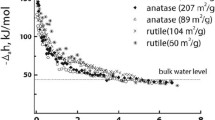Summary
The stability of Thorium dioxide sols at pH=3.5 was examined as a function of anionic surface active agents spectrophotometrically. At low concentrations of surface active agents, the stability of the sol decreases and attains a minimum value at concentrations 10−4 to 10−3 M. With increasing concentration the stability increases and attains a maximum at concentrations 10−3 to 10−2 M. The effect of the PH-value, the chain length and the head groups of the surface active agents are also studied. The results were explained on the basis of strong adsorption of these ions at the Stern plane.
Similar content being viewed by others
References
Ghosh andChattoraj, Kolloid-Z.158, 144 (1958).
Chattoraj, Kolloid-Z.158, 45 (1958).
Anderson, Trans. Faraday Soc.54, 130 (1958).
Douglas andBurden, Trans. Faraday Soc.55, 350 (1959).
Sowden andFrancis, Nucl. Sci. Eng.16, 1 (1963).
Ghosh andBandyopadhyay, J. Indian Chem. Soc.39, 309 (1962).
Boyd, House andMenis, U.S. Atomic Energy Comm. ORNL2836, 22 (1959).
Ottewill, Rastogi andWatanabe, Trans. Faraday Soc.56, 854 (1960).
Verwey andOverbeek, Theory of stability of Lyphobie Colloids, p. 152 (Amsterdam 1948).
Hamaker, Physica4, 1058 (1937).
Derjaguin, Trans. Faraday Soc.36, 730 (1960).
Derjaguin andLandau, Acta physicochem.14 633 (1941).
Bruyn andTroelstra, Kolloid-Z.84, 192 (1938).
Smoluchowski, Z. Physik Chern.92, 129 (1917).
Boyer andSegal, The mechanism of Enzyme Action, p. 520 (Baltimore 1954).
Ottewill andRastogi, Trans. Faraday Soc.56, 865 (1960).
Fuchs, Z. Physik89, 736 (1934).
Rastogi andSrivastava (to be published).
Ottewill andRastogi, Trans. Faraday Soc.56, 880 (1960).
Overbeek andSparnaay, Disc. Faraday Soc.18, 12 (1954);Derjaguin, Titijeskaja, Abrikossova andMalkiva, Disc. Faraday Soc.18, 24 (1954);Derjaguin, Abrikossova andLifshitz, Quart. Rev.10, 295 (1956);Kitchener andProsser, Proc. Rov. Soc. A242, 403 (1957).
Overbeek, Kolloid-Beih.59, 287 (1943).
Reerink andOverbeek, Disc. Faraday Soc.18, 74 (1958).
Author information
Authors and Affiliations
Rights and permissions
About this article
Cite this article
Rastogi, M.C., Srivastava, O.N. The stability of hydrophobic sols in the presence of surface active agents. Kolloid-Z.u.Z.Polymere 232, 804–811 (1969). https://doi.org/10.1007/BF01500659
Received:
Issue Date:
DOI: https://doi.org/10.1007/BF01500659




